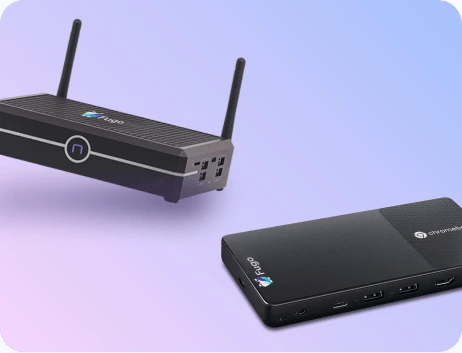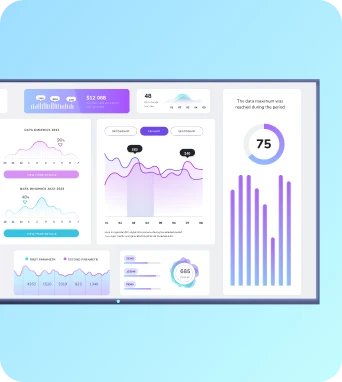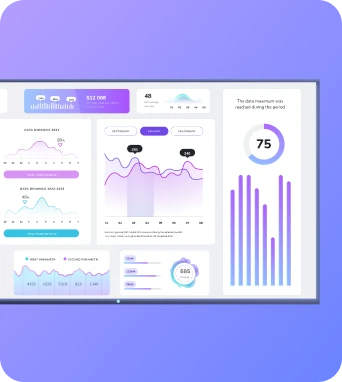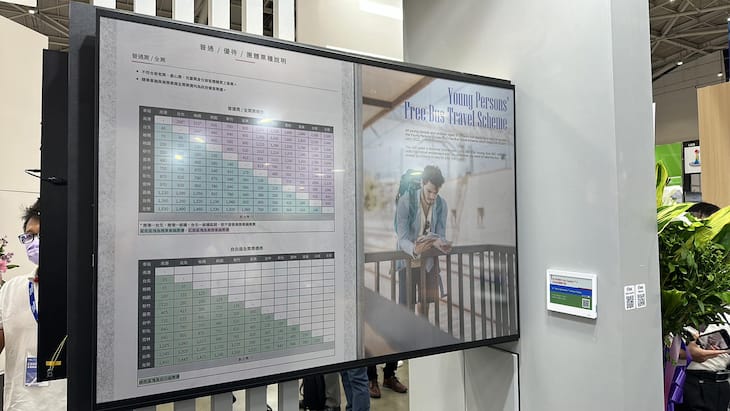E Ink is about to make digital signage a lot more interesting.
Although e-paper displays aren’t a brand-new concept, they’re starting to pick up steam. And with the advent of the first-ever 32-inch full color E Ink screen, LED and OLED are no longer your only two options for digital signage.
But let’s not get ahead of ourselves. Below, we’re taking a deep dive into all-things E Ink (aka e-paper). We’re also covering some advantages and disadvantages so you can get all the details at a glance.
Let’s start with the basics:
What is E Ink?
E Ink, also known as e-paper, is a type of digital display mimicking the look of ‘ink’ on a screen. Unlike traditional displays emitting light to create an image, e-paper relies on particles and ambient light to create high-contrast displays.
There are a couple of interesting sciences at work here:
- Electrophoretics: The ability to separate macromolecules based on an electric charge.
- Electrowetting: Using an external magnetic field to manipulate tiny amounts of liquid.
- Interferometry: Relying on wave interference (like electricity) to measure distances.
- Plasmonics: How the presence or absence of chemicals affects the color of plasmonic nanoparticles.
We’ll get into the specifics of how this works later. In the meantime, let’s get into the taxonomy of E Ink — particularly where the name came from.
The term ‘E Ink’ comes from the E Ink Corporation, the company (unsurprisingly) responsible for the original tech. Like band-aids, Kleenex, and Post-It-Notes, ‘E Ink’ simply become a ‘genericized’ term. The official term for E Ink tech is actually ‘e-paper.’ But let’s be honest: E Ink sounds way cooler. We’re going to use both terms interchangeably here, so don’t be confused if you see the two intertwined.
Anyway, E Ink technology has been around since 1997, although we’ve only been talking about it for the last couple of years. Remember the original Kindle launched in 2007? Yup, that was the E Ink Corporation.
Since then, scientists have become a whole lot better at building high-quality e-paper displays. We now have E Ink monitors, phone screens, and tablets, as well as the aforementioned 32-inch digital signage display.
But how does e-paper actually work? And why does that matter for digital signage?
Glad you asked…
How E Ink works
Remember playing with Etch-A-Sketch or Magna-Doodles as a kid? For the unfamiliar, it looks like this:
You could pull a magnetic stylus over thousands of tiny metal filings to create a blurry image over the hexagonal chambers. All you had to do was shake the box to remove the image and draw a new one.
This is a pretty accurate representation of what goes on with e-paper displays (except for the shaking part — don’t do that).
E Ink displays contain thousands of microcapsules, which are basically small bubbles filled with clear fluid. They contain hundreds of positively-charged black particles and negatively-charged white particles swimming around in a disorganized jumble.
From here, an electrical charge extends on both sides of the thin microcapsule layer — the top side negatively charged, and the bottom side positively charged. With electricity, the top side pulls black particles up, while the bottom pulls white particles down.
Unlike digital displays, which light up pixels on a screen, e-paper physically moves charged particles from one end of the display to another.
Now imagine if you have hundreds or thousands of microcapsules — packed not too loosely but not too tightly — on a single plane. Can you imagine the depth and variety of images you could display on an ambient screen?
Since its smash success in 2007, E Ink has been continuously innovated upon. A recent interview with the E Ink Corporation says the technology’s update time is four times faster, the contrast is five times higher, and the overall cost is up to seven times lower. Modern E Ink even has a ‘cyan, magenta, yellow, white’ system shuffled around like a card deck to produce intricate colors.
Scientists are still hard at work creating more use cases for e-paper. Today, dozens of companies are working on e-paper car wraps, clothing, furniture, and perhaps most excitingly, larger TV screens.
This is where the future of E Ink becomes oh-so exciting. We’re no longer consigned to just ebooks or checking time — we’re now able to display full-color digital signage for a lower cost, lower hassle, and for a longer period of time.
Keep reading to see a few more of e-paper’s many benefits.
The many advantages of an E Ink display
E-paper is way more than just a cosmetic update (although to be fair, that’s definitely part of it). Businesses and customers have a lot more to gain, including:
The ability to read text in direct sunlight
Many of us are used to glare and distortion when reading text on outdoor screens. Fortunately, the powerful rays of the afternoon sun aren’t a problem with e-paper displays.
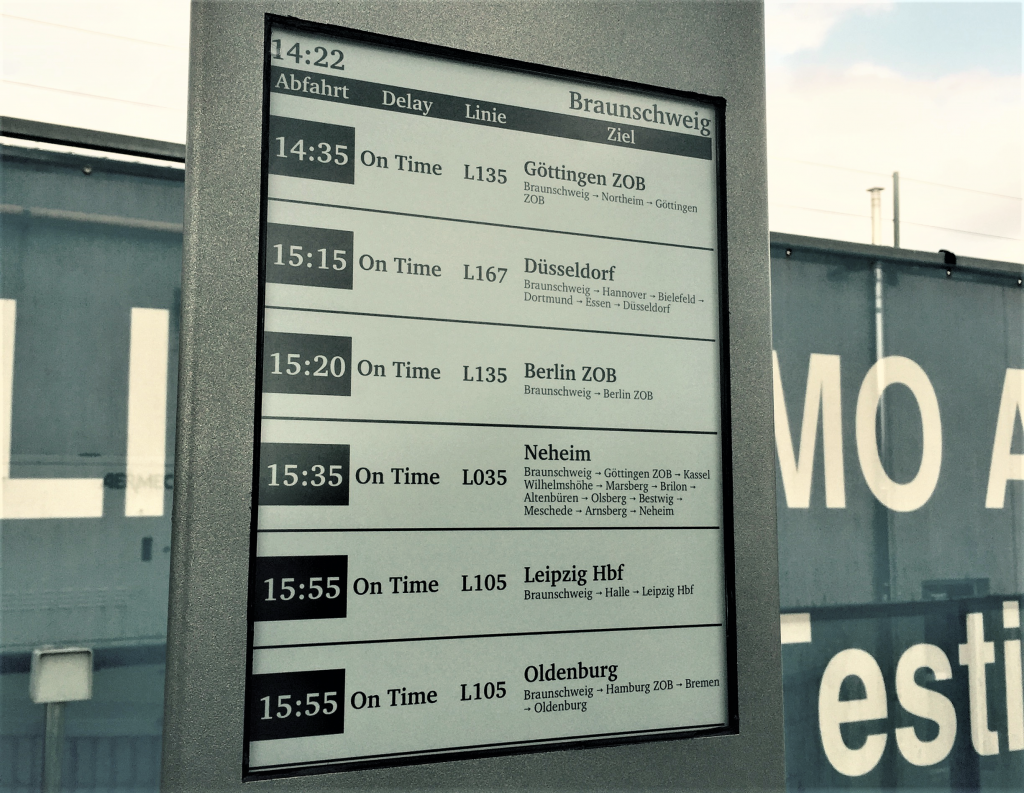
E Ink screens let you read in bright sunlight, since they rely on ambient lighting rather than LEDs. No more squinting at outdoor signs hoping you made out the letters correctly!
No more pushy light getting straight into your eyeballs
Since e-paper doesn’t produce light by itself, it’s far gentler on the eyes than traditional displays. You don’t have to worry about eye strain or the dangers of blue light, which can have long-term effects on your physical health.
And since E Ink displays don’t update like traditional LEDs, there’s no ‘flicker’ of light behind the scenes. This is far more comfortable for our digitally-strained eyes and much-appreciated by staff and customers.
No power requirement
You only need battery power to change your E Ink display — not to actually display things. This means you rarely have to change your display’s internal battery, which saves tons of time and money (not to mention carbon emissions).
You can easily run an e-paper display without a single outlet needed, and when you do have to replace the battery, you only have to worry about it once every one to five years. Good news: batteries will only get cheaper over time, since most major patents expired a few years ago.
The downsides of E-Paper
As much as we love e-paper at Fugo, we’re not going to pretend there aren’t any drawbacks. There are a few limitations with E Ink displays, including:
- Slower screen transitions: Since you’re physically moving particles rather than flashing a digital image, it may take a few seconds longer to change your display. It may also be frustrating to play videos on-screen (although some e-paper screens demonstrate 30 to 60 FPS). This probably isn’t going to matter for most people in the grand scheme of things, but it’s still a consideration (especially if you use videos in your digital signage program).
- The price tag: You might want to sit down before Googling the price of an E Ink display. Take a gander over to Amazon and type in ‘e-paper,’ and you’re likely going to fall into sticker shock. But there’s a good reason behind this relatively hefty price: these displays have extremely delicate designs and require a careful balance of componentry. Nevertheless, it’s still a drawback, especially when you consider the increasingly affordable cost of LED displays.
- Smaller screens: A 32-inch e-paper display is absolutely mind-blowing at this point. But of course, when it comes to 97-inch OLED screens (which are three times the size of the E Ink screen), it’s hard to feel impressed. Remember: E Ink displays are analog in nature and require lots of synergistic componentry. Reaching the color era was tough enough — it may be several years until we get a display bigger than 32 inches.
Why E Ink displays are a game changer for digital signage
E-paper displays are taking the world by storm. There’s a good chance you’ve seen a few of them, too — in bus stations, grocery stores, traffic circles, and other locations.
But with the promise of larger screens and full-color displays, there are an increasing number of use cases (and advantages) to keep in mind.
For example:
Battery life lasts (pretty much) forever
Traditional screens guzzle heaps of power to showcase digital displays. Apart from costing you hundreds in unnecessary electricity costs, they may contribute to light pollution as well.
That’s not the case with E Ink displays. Since the new Philips Tableaux 5150I is going to be a zero power consumption option, there are all sorts of possibilities and digital signage applications. You can spend less on electricity, replace the battery less frequently, and worry less about the effects of light pollution.
You don’t need any outlets nearby
It’s true! You don’t need a single power outlet to put e-paper signage on display. This makes it a great option for constant remote updates, especially for signage on outdoor screens (like train terminals and bus stations, for example).
Keep in mind there are solar-powered E Ink screens already in the works. Even if you do need constant display switching, the ambient charging can subsidize your need for new batteries.
Achieve your business’s emissions goals
The carbon footprint of an E Ink display is much lower than your traditional TV. As of 2022, the emissions of every 6.8 inch e-paper module were 3.30 kilograms of carbon. Every 2.9 inch e-paper module emitted a scant 0.59 kilograms of carbon. That’s a far cry from energy-efficient LEDs like the TCL 3-Series 49”, which produces around 74 kilograms of CO2 per year.
Even if you divide these numbers for a more equivalent comparison, you’re still getting 10.5 kilograms of CO2 for every seven inches of TV. This is more than three times the emissions of the 6.8 inch e-paper module, which again highlights the huge potential of E Ink displays.
Clearly viewable from multiple angles
Traditional LEDs aren’t always visible at sharp angles. Depending on their mounting style and specific brightness levels, displays could be difficult for customers to read (especially at longer distances).

In contrast, E Ink displays are great for long distances and operate well even at 180-degree angles. The high-contrast, low-glare, and ambient lighting setup produces visible content in a wide variety of perspectives. It’s like a paper poster crossed with a TV — just without the need for electrical plug-ins.
Unique applications for screens
You can use E Ink displays in a wide variety of environments, including those typically too harsh or rough for delicate OLEDs. Even outdoors, e-paper tablets are an excellent option for interactive content, with the new 32-inch screen acting a catalyst for larger displays.
There also happens to be a wide variety of methods for updating content with E Ink, as the new 32-inch screen accompanies 16GB of internal memory and 2GB RAM. You can also update your display via USB, micro USB, Micro SD, LAN, or WiFi 5, meaning it’s easier than ever to upload, display, and alter content on your screen.
Looking forward
The E Ink era is here to stay. And as you can see, there’s a lot to look forward to.
That said, you probably shouldn’t be looking to replace all your screens with e-paper. Not every use case needs an analog display, after all. But don’t let this opportunity pass you by. Coupled with the ability to display colors at low power consumption, E Ink is a great secret ingredient in your digital signage program’s recipe for success.
